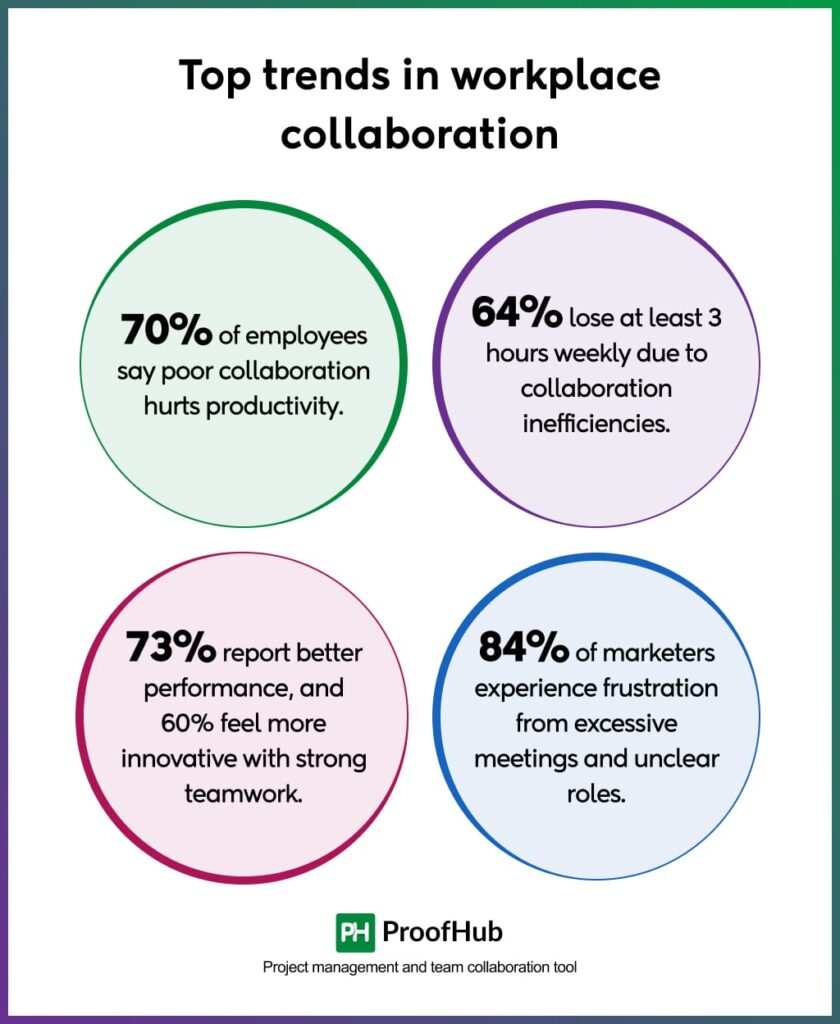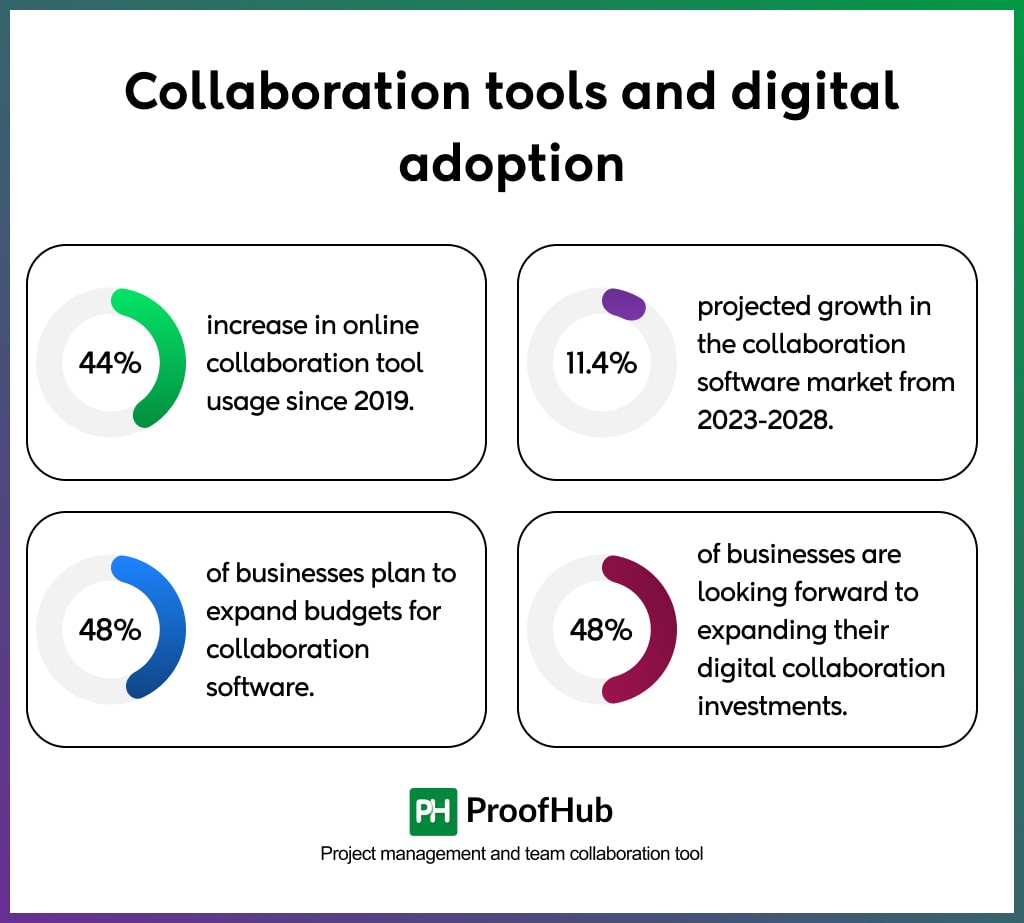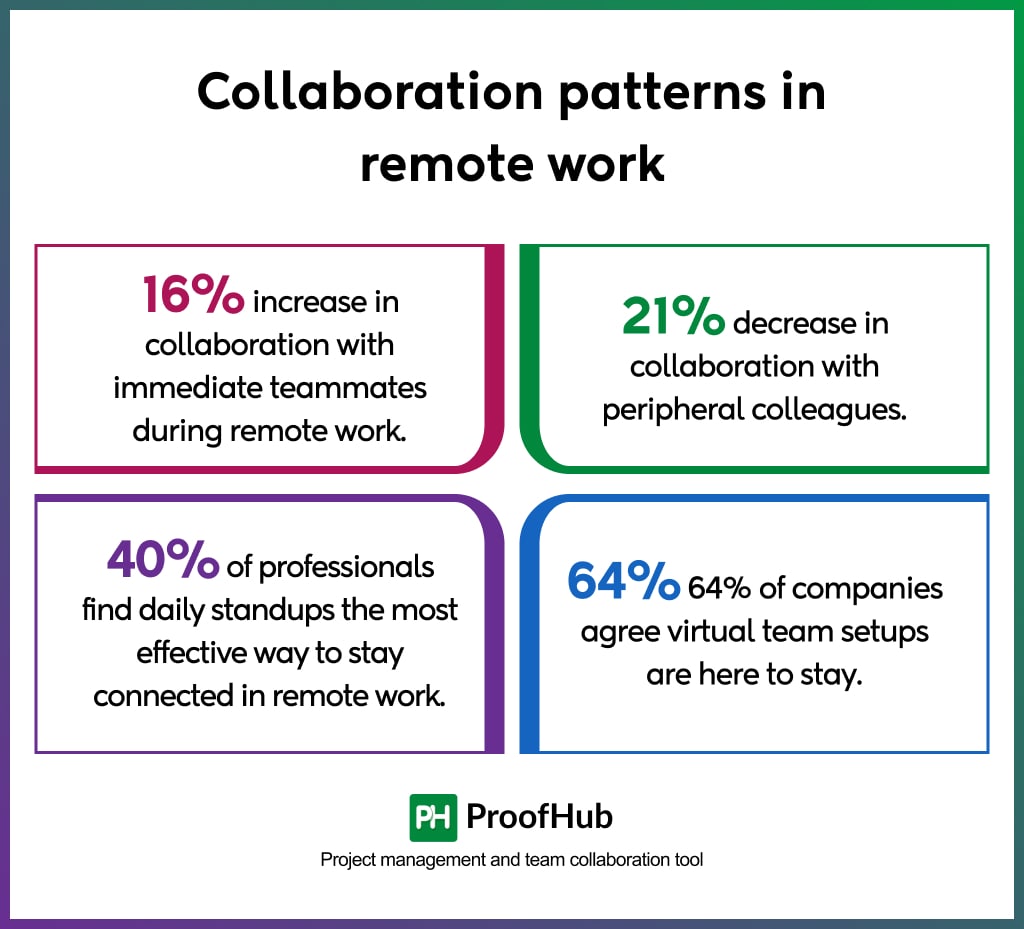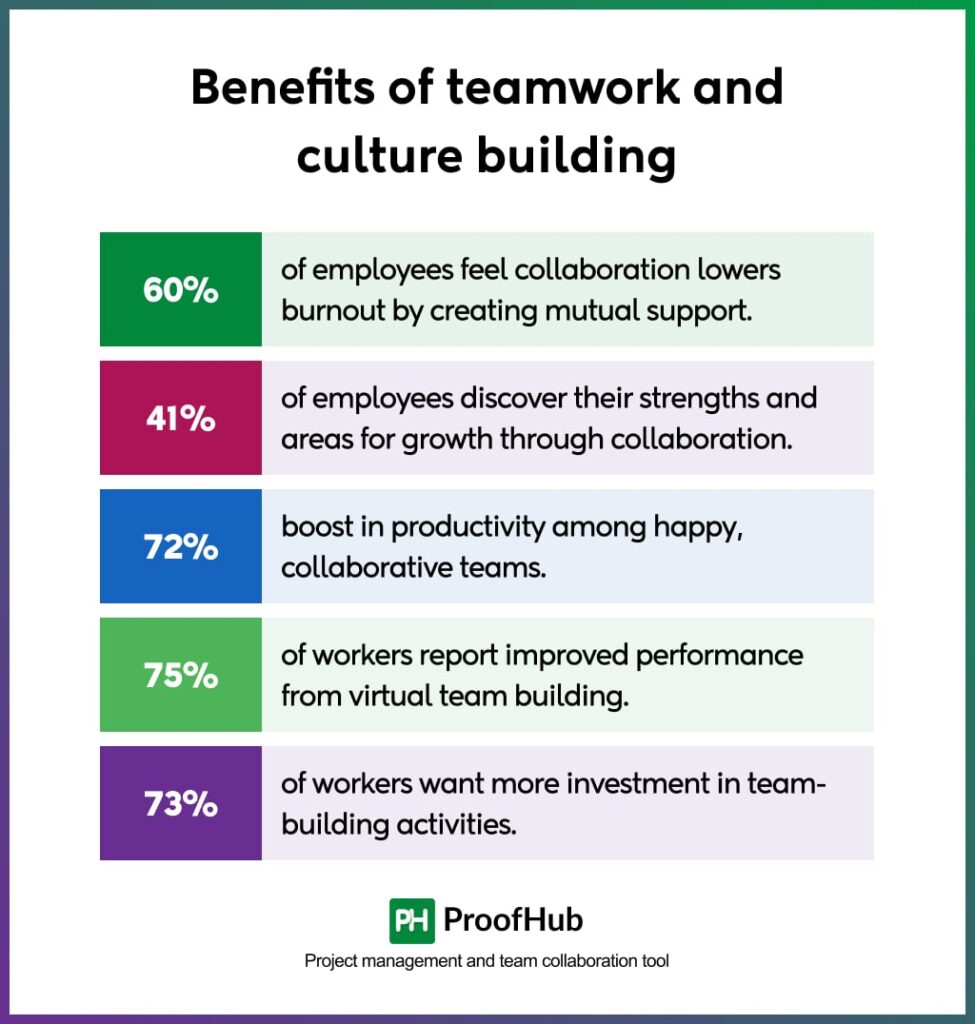Data has a way of distilling complex realities into insights that drive accurate, impactful results. Throughout my career, I’ve relied on data to guide complex decisions. Whether I’m measuring campaign impact or strategizing for the next quarter, the most valuable insights usually come from rows and columns of numbers.
Yet, some trends are unmistakably clear. When it comes to workplace collaboration, the numbers are strikingly transparent. Over just a few years, how we work together has evolved remarkably, shaped by new technologies, remote and hybrid team structures, and shifting generational expectations.
This article brings together the latest statistics on workplace collaboration to give you a snapshot of these changes. Through data, we’ll uncover the trends, challenges, and strategies that are reshaping how teams work together. Whether you’re managing a team or working within one, these insights aim to help you make informed decisions and stay ahead.
47 important workplace collaboration statistics for effective teamwork
The data on modern workplace collaboration paints a vivid picture. While some studies show a growing disconnect between employee expectations and the reality of collaboration tools and practices, others highlight the incredible potential for increased productivity through better digital collaboration. As remote and hybrid work environments continue to reshape team dynamics, understanding these shifts is critical. Here are some of the top trends in workplace collaboration, grounded in the latest data.
Top trends in workplace collaboration
Understanding the true impact of collaboration goes beyond common assumptions about teamwork. The data reveals that effective collaboration directly influences performance, sparks innovation, and can even determine a company’s ability to meet its goals. However, collaboration also has its challenges—inefficiencies, role confusion, and wasted time can hinder progress, especially in larger or remote teams.

- A Deloitte study found that 73% of employees who engage in collaborative work report improved performance, while 60% say it sparks their innovation. This shows that teamwork and collaboration directly contribute to individual and team success.
- The cost of poor collaboration is measurable, and it’s staggering. Studies reveal that 64% of employees waste at least three hours a week due to collaboration inefficiencies, with 20% losing up to six hours. That’s a significant drain on productivity, especially when you consider how much more could be accomplished with the right tools and processes in place.
- A common pain point Collaboration drag is a pervasive issue, especially in larger teams and organizations. A Gartner survey found that 84% of marketers experience frustration and inefficiency from excessive meetings, redundant feedback loops, and unclear roles. These issues hinder job satisfaction and impact the company’s ability to meet its revenue goals, highlighting the direct connection between collaboration inefficiencies and business performance.
- It’s not all doom and gloom. There’s good news for marketers and leaders alike. The same survey reveals that CMOs can reduce collaboration drag by as much as 23% through targeted skill-building initiatives and strategic talent investment. Organizations can unlock significant productivity gains by fostering a culture of effective collaboration.
- The shift to remote work has dramatically altered how employees interact with each other. Insights from the Humanyze platform reveal that the pandemic led to a 16% increase in collaboration with immediate teammates—those employees rely on most and interact with regularly. Interestingly, though, there was also a 21% decrease in collaboration with peripheral colleagues, the ones outside of a person’s immediate team. This could pose challenges to cross-functional innovation, as these more distant connections often spark fresh ideas and insights.
- Agile engagement programs have proven to be powerful for driving growth. Companies implementing agile engagement programs, such as regular check-ins (four or more per year), grew up to 10 times faster within 12 months compared to those with traditional approaches. This trend reflects the tangible impact of frequent feedback and agile strategies on overall organizational growth.
- Interestingly, 20% to 35% of all high-value collaborations are contributed by just 3% to 5% of employees. This small core of high collaborators is crucial to success but is also at risk of burnout due to the disproportionate responsibility. It’s a reminder that balanced collaboration isn’t just about quantity but sustainability, ensuring top contributors have support to avoid long-term fatigue.
- There’s notable resistance to change within organizations, but the demand is growing. Nearly two-thirds of employees believe their organization should change how it works and collaborates, but don’t expect this shift to happen soon. Among emerging leaders aged 30-35, over 50% feel that collaboration will become even more essential for their success, showing that the next generation of leaders is keenly aware of this need.
- Physical workspaces are another crucial element in collaboration. A flexible environment can make a remarkable difference in how employees feel and work. Approximately three-quarters of office workers report having control over where to work within the office, and 81% of those who enjoy a positive workplace experience cite choice in the workspace as essential. Offices now feature varied spaces for focused work, collaborative sessions, and rejuvenation, striking a balance that supports productivity.
- Access to inclusive technology is becoming non-negotiable in hybrid settings. 70% of hybrid employees adapt their meeting structures to ensure inclusivity and equal participation, compared to only 49% of on-site employees.
- Artificial Intelligence is actively improving collaboration. Real-time feedback through AI systems has been linked to a 40% improvement in project turnaround times. Teams can adjust quickly and move forward with confidence, fostering a more adaptive, responsive approach to team projects.
- According to a Salesforce report, 86% of business leaders attribute workplace failures to a lack of collaborative teamwork. This shows how critical teamwork is to success, suggesting that nurturing collaboration can help prevent project delays and inefficiencies.
- Teamwork increases sales by 27%. Collaborative efforts directly impact revenue by improving sales, emphasizing the bottom-line benefits of teamwork.
- 28% of marketers find collaboration boosts visibility. Collaboration in marketing expands reach and visibility, suggesting teamwork can increase brand awareness and recognition.
Growing use of collaboration tools
The shift toward digital collaboration is on the rise, with businesses increasingly relying on technology to bridge distances and support remote teams. As more organizations adopt collaboration software, the market is poised for significant growth, driven by the demands of hybrid and remote work.

15. The global collaboration tools market is projected to grow from US$ 39,407.4 million in 2023 to US$ 116,338.4 million by 2033, with a robust CAGR of 11.4% over the next decade. This growth reflects an increasing need for tools that support remote teams, streamline workflows, and enhance productivity.
16. Additionally, 76% of the global workforce now relies on video conferencing and other collaboration tools, making virtual meetings a central component of daily operations—especially as hybrid work models gain traction.
17. Usage of online collaboration tools has surged by 44% since 2019, spurred by remote work demands. In 2021, 48% of businesses planned to expand their collaboration software budgets, reflecting the critical role of these tools in maintaining team productivity and cohesion in remote environments.
18. 47% of Baby Boomers never turn on their camera during video conferences, compared to only 22% of Gen Zers who report the same behavior. This indicates a significant generational difference in the comfort level and willingness to use video during remote meetings.
19. 46% of employees surveyed by Forbes believe that colleagues with their video on appear more engaged and involved in meetings, while 39% feel that filming themselves during a videoconference conveys an impression of competence and professionalism. This highlights the positive perception of video usage in enhancing engagement and professionalism in remote interactions.
The growing reliance on collaboration tools showcases their importance in building effective teams, with companies reporting streamlined communication, increased productivity, and alignment with organizational goals.
Remote and hybrid work collaboration
While collaboration tools are essential, they aren’t a catch-all solution without a structured plan. As remote work continues to evolve, businesses must create clear collaboration strategies to bridge the gap between home and office environments.

A LinkedIn poll I conducted revealed that 40% of professionals prefer daily standups as the best way to stay connected remotely. 22% favored informal check-ins, while 20% emphasized periodic feedback. This highlights the importance of balancing structured and casual interactions in remote work.
The data highlights a key issue for hybrid teams: the difficulty of maintaining collaboration and productivity when workers are split between remote and in-office settings.
20. A McKinsey survey found that 41% of employees felt more productive working remotely than in an office setting. As employees gain experience with remote work, confidence in their productivity has increased, suggesting that effective collaboration can occur outside traditional office environments if supported by the right tools
21. Research indicates that 30% of employees expect remote work to remain permanent as companies adapt to new workforce preferences. This shift is particularly influenced by the entry of Gen Z into the workforce, who prioritize flexibility in their work arrangements.
22. Fully remote work arrangements are expected to continue decreasing from three in 10 remote-capable employees in June, down to two in 10 for the long term, despite 34% wanting to permanently work from home.
23. 83% of employees believe they work more efficiently and productively in remote settings. However, this presents an interesting disconnect, as only half of HR leaders view employee productivity as a primary benefit of remote work. This gap poses a crucial challenge for managers who must bridge the divide between employee perceptions and organizational expectations.
24. The American Opportunity Survey reveals that 58% of employed respondents have the option to work from home at least part-time, highlighting the growing acceptance of remote work as an integral part of company culture.
25. Approximately 38% of corporate executives expect employees to work remotely for two or more days a week post-pandemic, indicating a strong trend towards hybrid models that combine both remote and in-office collaboration. However, only 19% anticipate employees working three or more days remotely, suggesting a balance is sought between flexibility and the benefits of in-person teamwork.
The shift toward hybrid work environments requires planning and thoughtful collaboration models to ensure that all team members, whether at home or in the office, can work together efficiently.
The cultural aspects of collaboration
As teams continue to grow more interconnected, it’s essential to understand how cultural elements, such as strong leadership and diverse perspectives, contribute to building high-performing teams.
26. According to a Microsoft survey, 96% of decision-makers and 95% of employees identify communication as crucial for workplace success. As teams become more interconnected, clear communication helps avoid misunderstandings, supports project success, and reduces stress.
27. Nearly 40% of Gen Z and millennial workers report that workplace culture has “a great deal” of impact on their intent to stay at their current job. This highlights the importance of fostering a positive and inclusive culture to retain younger employees, who are particularly sensitive to cultural fit in their workplaces.
28. A lack of clarity in communication is a significant stressor, with 80% of employees reporting stress due to unclear instructions. Moreover, 46% often spend up to 40 minutes daily resolving confusion. This highlights the need for clear, structured communication to support team well-being and productivity.
29. Research reveals that high-performing teams exhibit five main traits: strong team members, collaborative problem-solving, solid relationships, good leadership, and supportive organizational culture. Yet, only 20% of executives consider their teams to be high-performing. Focusing on these elements can elevate team effectiveness and drive impactful results.
30. Gartner’s research shows that diverse teams achieve 12% higher performance, as different perspectives fuel innovation. Similarly, McKinsey found that teams aligned with a shared vision are 1.9 times more likely to surpass financial goals, underscoring the value of both diversity and alignment in team success.
From empowering high-value collaborators and providing adaptable workspaces to investing in agile engagement and technology, businesses have clear opportunities to enhance teamwork. For companies willing to invest in these areas, the rewards can change both employee experience and organizational success.
Challenges to collaboration in 2026
Whether it’s reducing miscommunication, breaking down silos, or offering better support for remote workers, organizations need to address the barriers hindering collaboration. While high workloads and team dynamics are significant stressors, the true obstacles often lie in communication breakdowns and organizational silos.
31. With 39% of employees identifying workload and 36% pointing to people issues as stress factors, it’s clear that poor team interactions amplify stress, emphasizing the need for effective collaboration frameworks.
32. Miscommunication causes 28% of missed deadlines, highlighting how unclear exchanges can lead to delays and errors. Structured communication channels are essential to keep teams aligned and productive.
33. 41% of employees find it more challenging to collaborate across departments than within their own teams, indicating a need for improved coordination across organizational silos.
34. Unengaged and actively disengaged employees contribute to an estimated $1.9 trillion in lost productivity across the U.S. annually. Effective managerial support can play a pivotal role in reducing disengagement, thereby improving productivity and collaboration in the workplace.
35. Email remains the primary communication tool for 88% of remote workers. However, this heavy reliance on email often creates challenges that can disrupt smooth collaboration and effective team communication.
36. Over half of U.S. employees have limited or no insight into other teams’ objectives, which can create fragmented work environments. Transparency promotes alignment and breaks down silos.
36. Remote employees experiencing isolation report a 21% drop in productivity, highlighting the importance of inclusive, connected team environments to sustain performance.
These challenges highlight the urgent need for clear communication channels, transparency, and more cohesive frameworks to help teams work together, in-person or remotely.
Making collaboration a strategic priority
Effective collaboration isn’t just an operational goal; it’s a strategic necessity. Data shows that investing ample time in forming your collaboration strategies improves productivity, reduces burnout, and enhances employee engagement.

37. 60% of workers report that collaboration reduces burnout by providing mutual support. A collaborative environment can serve as an emotional buffer, promoting resilience and engagement.
38. Collaboration enables 41% of employees to recognize their strengths and weaknesses, promoting personal growth and self-awareness.
39. Happy employees are 13% more productive, with a 72% boost in effectiveness when collaboration is high. Positive team dynamics enhance both morale and performance.
40. Effective teamwork can reduce absenteeism and enhance engagement by 60%, supporting a culture of commitment to shared goals.
41. Nearly all employees and employers (97%) agree that lack of collaboration undermines workplace success, emphasizing teamwork’s critical role in achieving organizational goals.
42. An experimental study reveals that teams of 3 to 5 members perform best when solving complex problems, as they share and validate ideas efficiently. However, two-person teams completed tasks like assembly faster than larger teams, suggesting that team size should be tailored to task complexity.
By keeping collaboration at the forefront, companies can create a more productive, connected, and resilient workforce, one that not only achieves goals but surpasses them. The key takeaway? Collaboration is not just a tactic; it’s a strategic necessity for success.
Managerial impact on engagement and culture
Managers play a vital role in cultivating collaborative and engaged teams. Effective leadership and a culture of trust are fundamental to employee satisfaction and retention.
43. According to Gallup, managers account for 70% of the variance in employee engagement, underscoring their influence in building collaborative teams. Managers who actively collaborate with employees drive higher engagement and, consequently, performance.
44. Only 33% of U.S. employees were engaged at work throughout 2023, a decline from the peak engagement rate of 40% in 2020. This engagement gap underscores the need for managers to actively strengthen team connections, set clear expectations, and support employees’ alignment with organizational goals to enhance collaboration.
45. Over 90% of Gen Z workers prioritize authenticity, indicating that being true to oneself is among their highest values. If they feel they cannot be their authentic selves at work, they are likely to seek opportunities elsewhere. This statistic underscores the necessity for managers to create environments that support individual authenticity and promote a sense of belonging.
46. While 90% of C-suite executives report being satisfied with the technology their company provides for critical work, only 68% of staff feel the same way. This gap underscores the need for managers to actively seek feedback from their teams and address their unique technology challenges.
47. In companies where employees are empowered to make delegated decisions, the likelihood of success increases by 3.9 times. When managers provide coaching and create safe spaces for experimentation, it builds a collaborative culture with a strong sense of ownership and accountability across the team.
Final word
As the data reveals, effective teamwork improves performance, enhances job satisfaction, fosters a positive work culture, and boosts organizational resilience. With the shift to hybrid and remote work models, having the right tools to bridge physical distances and streamline communication is crucial.
Navigating these shifts requires more than any tool—it demands a robust, adaptable solution that aligns with modern team dynamics. Whether through task management, streamlined communication, or transparent project tracking, the right platform can transform how teams interact and perform. In this landscape, tools like ProofHub have been recognized for effectively addressing collaboration pain points and bringing people and projects together in one cohesive space. Embracing the right technology is a strategic step forward in making collaboration work, now and in the future.

